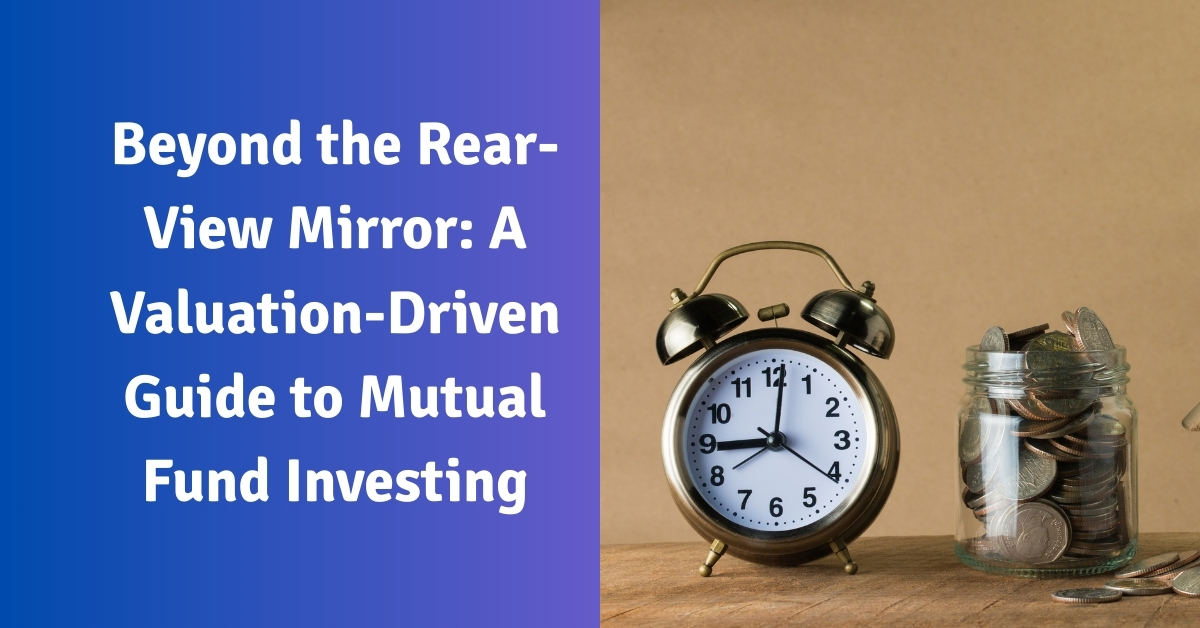Beyond the Rear-View Mirror: A Valuation-Driven Guide to Mutual Fund Investing

In the world of investing, one of the most common and costly mistakes is driving while looking only in the rearview mirror. Many investors, armed with last year’s performance charts and star ratings, pour their hard-earned money into mutual funds that have already seen their best days. This approach, known as chasing past returns, is akin to betting on a horse that has already won the race. It’s a flawed strategy because, as any seasoned investor knows, market leadership is cyclical and yesterday’s winners are often tomorrow’s laggards.
So, how do the professionals build robust, long-term portfolios? They shift their gaze from the rearview mirror to the road ahead. Their process is not dictated by past performance but by a rigorous, forward-looking analysis of asset allocation, market capitalization, sector valuation, and qualitative factors. This blog post will demystify this disciplined approach and provide a roadmap to help you construct a smarter, more resilient mutual fund portfolio.
The Foundation: Asset Allocation First
Before you even think about selecting a specific mutual fund, the most critical decision you will make is your asset allocation. This refers to how you distribute your investment capital across different asset classes, primarily equities (stocks), debt (bonds), and gold. This strategic mix is the single most important determinant of your portfolio’s long-term returns and volatility.
For an investor with an aggressive risk profile, a portfolio might be structured with approximately 70% in equities, 17% in bonds, and 13% in gold. This blend is designed to capture the growth potential of stocks while using bonds and gold as stabilizing forces to cushion against market downturns. Getting this mix right is far more crucial than finding the single “best” equity fund, as it diversifies your risk and provides a more stable foundation for wealth creation.
A Disciplined Approach to Equities: The Market Cap Balancing Act
Once your overall asset allocation is set, the next step is to drill down into the equity portion. Here again, a valuation-driven approach is paramount. A common mistake among retail investors is to be lured by the spectacular past returns of mid-cap and small-cap funds, leading them to over-allocate to these volatile segments, often at inflated prices.
A more prudent strategy involves skewing the equity allocation heavily towards large-cap stocks, perhaps around 90%, with smaller, tactical allocations to mid and small-cap funds. This decision isn’t based on a bias against smaller companies but on a disciplined assessment of current market valuations. The goal is to allocate capital where the expected future returns are most reasonable relative to the risk being taken. By focusing on large, stable companies, the core of the portfolio is anchored, while smaller allocations to mid and small-caps can be made when valuations in those segments become attractive.
The Secret Sauce: Strategic Sector Selection
This is where the real art of portfolio construction comes into play. Even within the same category, such as large-cap funds, performance can vary dramatically. The key differentiator is the fund’s sectoral allocation. A forward-looking strategy involves identifying and overweighting sectors that are currently undervalued and poised for future growth, while reducing exposure to sectors that appear overvalued.
Currently, sectors like financial services, automobiles, consumption, and FMCG (Fast-Moving Consumer Goods) present attractive valuations. In contrast, sectors such as energy, infrastructure, and metals appear to be overvalued after a strong run. Therefore, a smart investor would look for mutual funds that have a higher allocation to the former group and are underweight in the latter. This sectoral tilting, based on rigorous valuation analysis rather than recent performance, significantly improves the probability of outperforming the benchmarks as market cycles turn and valuations revert to their historical averages.
Why Rankings Can Deceive You
The powerful influence of sector cycles explains why mutual fund rankings can be so volatile and misleading. A fund can languish at rank 150 one year and skyrocket to the top of the charts the next. This often happens because the fund was heavily invested in a sector that was out of favor. When that sector rebounds, the fund’s performance and its ranking surge.
An investor who buys a fund based on its number one ranking is often unknowingly buying into a sector that has already peaked. They are late to the party. This volatility underscores the danger of using simplistic, backward-looking metrics like star ratings or annual rankings for fund selection. It reinforces the need for a disciplined, valuation-first approach.
The Human Element: Assessing the Fund Management
Beyond all the quantitative analysis of valuations and sectors, a crucial qualitative assessment is necessary. A well-positioned portfolio is only as good as the team managing it. Therefore, the final layer of analysis involves looking at the people and processes behind the fund.
This includes evaluating the fund manager’s experience, their track record across different market cycles, and the reputation of the asset management company (AMC). A strong fund house will have robust risk management practices and a consistent investment philosophy. This holistic assessment ensures that the chosen funds are not only quantitatively sound but are also managed by competent teams capable of navigating the market’s inherent uncertainties.
Conclusion: Build for the Future, Not the Past
Constructing a successful mutual fund portfolio is a disciplined, research-driven process that prioritizes future potential over past glory. It begins with a solid foundation of asset allocation, followed by a valuation-based approach to market-cap distribution. The real outperformance is often generated by strategically tilting the portfolio towards undervalued sectors that are poised for growth. Finally, a qualitative check on the fund management team adds a layer of security.
By adopting this forward-looking methodology, investors can move away from the often-fruitless chase of past returns and build a portfolio that is better equipped to handle market volatility and achieve long-term financial goals.
FAQs
- Why shouldn’t I just pick the 5-star rated fund?
Ans- Star ratings are based on past performance, which is not a reliable indicator of future returns. A top-rated fund today might be heavily invested in an overvalued sector that is due for a downturn.
- What is asset allocation?
Ans- It is the strategy of dividing your investment portfolio among different asset categories, such as stocks, bonds, and gold, to balance risk and reward.
- Why is the recommended allocation to large-cap funds so high?
Ans- This is a valuation-based decision. A higher allocation to large-caps provides stability, with smaller, tactical investments in mid and small-caps when their valuations are attractive.
- What does it mean for a sector to be “undervalued”?
Ans- An undervalued sector is one where the collective stock prices of its companies are low relative to their earnings, assets, and future growth potential, suggesting they may have more room to grow.
- How often should I review my mutual fund portfolio?
Ans- It’s generally recommended to review your portfolio at least once a year, or when there are significant changes in your financial situation or the market, to rebalance your asset allocation if necessary.
- Is gold a necessary part of a portfolio?
Ans- Gold often acts as a safe-haven asset, performing well when other assets like equities are falling. It can provide valuable diversification and reduce overall portfolio volatility.
- Does a valuation-based strategy guarantee higher returns?
Ans- No investment strategy can guarantee returns. However, a valuation-based approach increases the probability of making sound investment decisions by focusing on fundamental value rather than market sentiment.
- What are qualitative factors in fund selection?
Ans- These are non-numerical aspects like the fund manager’s experience, the investment firm’s reputation, and the consistency of the investment process.
- If a fund’s rank changes so much, are rankings useless?
Ans- While they shouldn’t be the primary basis for a decision, rankings can be a starting point for research. Understanding why a fund’s rank has changed is more important than the rank itself.
- What’s the biggest mistake investors make with mutual funds?
Ans- The most common mistake is chasing past performance buying a fund simply because it did well last year, without considering its valuation, sectoral exposure, or suitability for their own goals.
Disclaimer: The information provided here is for educational and informational purposes only and should not be construed as financial, legal, or tax advice. Consult with a qualified professional before making any investment decisions. We do not accept any liability for errors or omissions in this information nor any direct, indirect, or consequential losses arising from its use.



